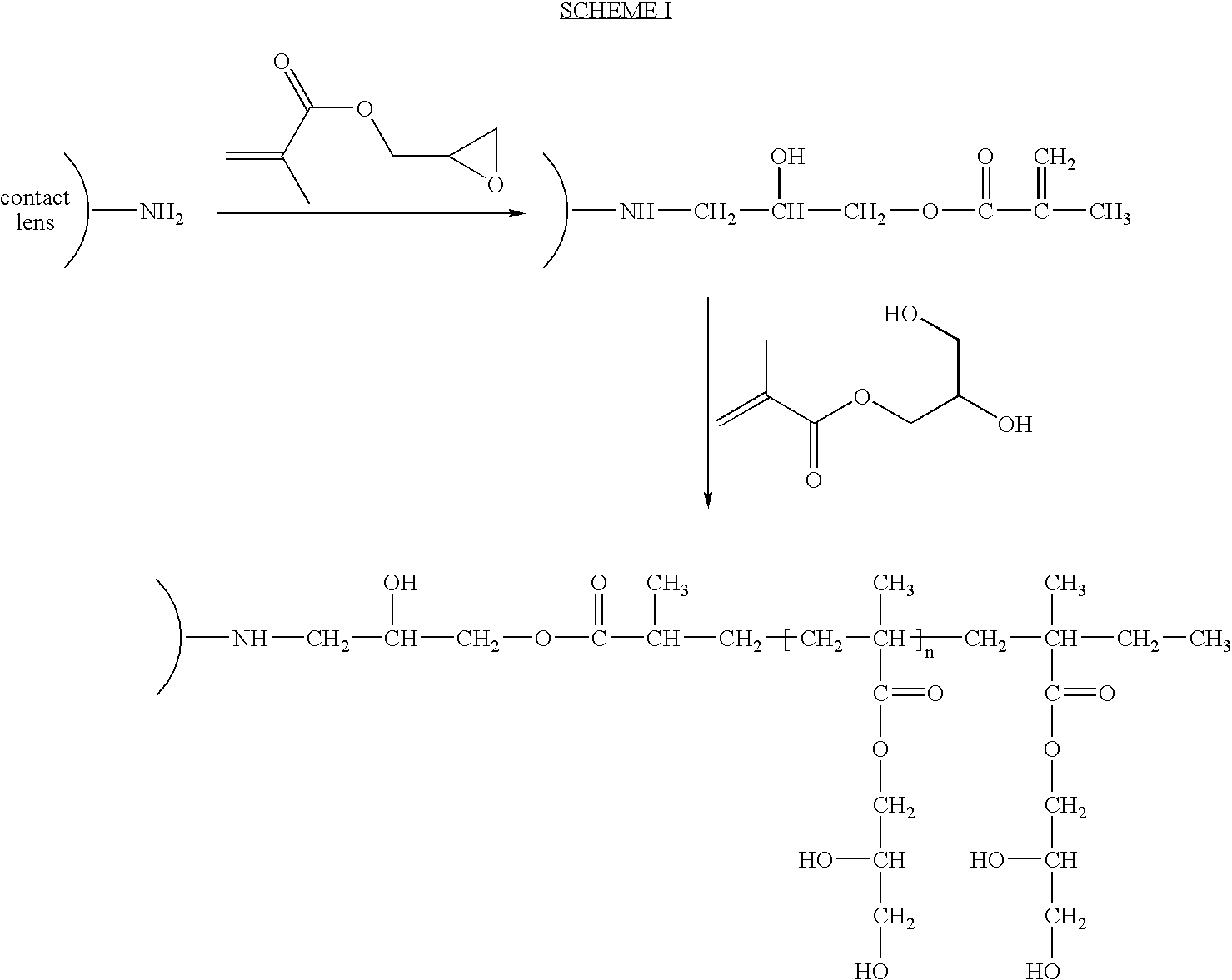Method for Making Surface Modified Biomedical Devices
a biomedical device and surface technology, applied in the direction of prosthesis, pharmaceutical delivery mechanism, coating, etc., can solve the problems of eye discomfort or even inflammation, surface of the lens can affect the susceptibility of deposition of the lens, and the process is disclosed, so as to achieve simple and cost-effective effects
- Summary
- Abstract
- Description
- Claims
- Application Information
AI Technical Summary
Benefits of technology
Problems solved by technology
Method used
Image
Examples
example 1
[0039]Step I: Bausch & Lomb PureVision® lenses, after being cast and solvent removed, were plasma-treated in a capacitively coupled plasma chamber using a 13.56 MHz RF source under the following conditions.
[0040]Ammonia gas 200 Watts RF, 0.3 torr chamber pressure, 1 min RF exposure
[0041]Butadiene gas 400 Watts RF, 0.2 torr chamber pressure, 1 min RF exposure
[0042]Ammonia gas 200 Watts RF, 0.3 torr chamber pressure, 1 min RF exposure
[0043]The plasma treated lenses were then dipped in a solution of tetrahydrofuran (THF) containing 5% acryloyl chloride overnight. The resulting lenses were hydrated in deionized (DI) water and then saved in DI water.
[0044]Step II: The hydrated lenses of step I were autoclaved in DI water containing 10 weight % N-vinyl pyrrolidone (NVP) and 1 weight % azo bis-isobutylnitrile (AIBN) for 30 minutes at 121° C. After the autoclave was completed, the surface modified lenses were stored in a borated buffer solution (BBS).
XPS Analysis
[0045]The lenses obtained af...
example 2
[0050]Step I: Bausch & Lomb PureVision® lenses, after being cast and solvent removed, were plasma-treated in substantially the same manner as in Example 1. The plasma-treated lenses were then dipped in a solution of THF containing 5% acryloyl chloride overnight. The resulting lenses were hydrated in DI water and then saved in DI water.
[0051]Step II: The hydrated lenses of step I were autoclaved in DI water containing 10 weight % glycerol methacrylate and 0.2 weight % AIBN for 30 minutes at 121° C. After the autoclave was completed, the surface modified lenses were stored in a BBS. The lenses obtained after steps I and II were analyzed for their atomic concentration by XPS and their contact angles were measured as described above. The XPS results and contact angles for the lenses are set forth below in Table 2.
TABLE 2ContactAngle(degrees)C1sN1sO1sStep I80.9(5.5)67.7(2.5)3.4(0.7)19.3(1.0)Step II61.0(8.6)64.9(1.6)2.9(0.3)25.2(0.6)
As the data show, the contact angles of surface of the l...
PUM
| Property | Measurement | Unit |
|---|---|---|
| mol % | aaaaa | aaaaa |
| mol % | aaaaa | aaaaa |
| mol % | aaaaa | aaaaa |
Abstract
Description
Claims
Application Information
 Login to View More
Login to View More - R&D
- Intellectual Property
- Life Sciences
- Materials
- Tech Scout
- Unparalleled Data Quality
- Higher Quality Content
- 60% Fewer Hallucinations
Browse by: Latest US Patents, China's latest patents, Technical Efficacy Thesaurus, Application Domain, Technology Topic, Popular Technical Reports.
© 2025 PatSnap. All rights reserved.Legal|Privacy policy|Modern Slavery Act Transparency Statement|Sitemap|About US| Contact US: help@patsnap.com



